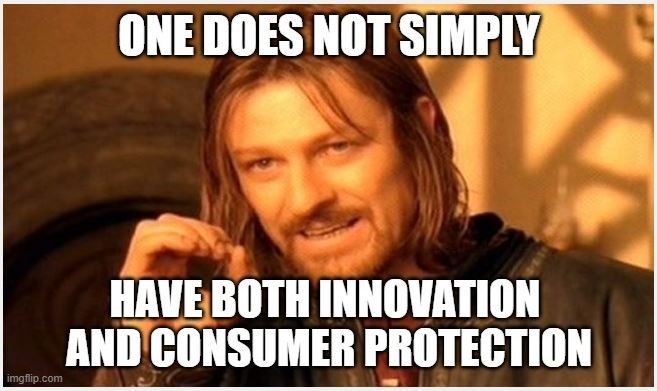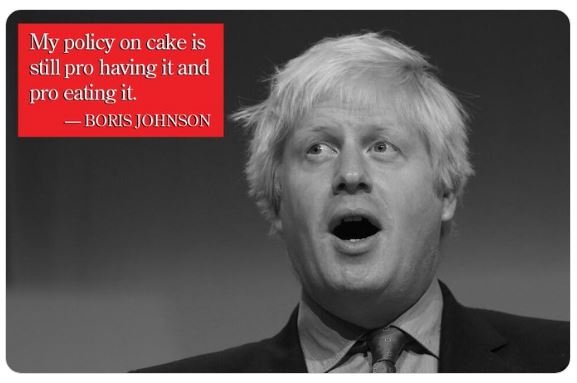Chapter 2.3 MiCA, blockchain innovation and consumer protection
-78. In the previous chapter I presented a cursory, rather generic analysis of MiCA’s provisions. Here I will be integrating the main concepts and conclusions concerning the “blockchain innovation” reached in Part 1 in order to explore the likelier ways in which the regulation will “affect technological and economic innovation.”
-79. The conclusion I reach is not optimistic with respect to Europe’s effort to advance toward the objectives of the Treaties. Indeed, I argue that MiCA appears as one step further down the path of economic underperformance on which Europe has engaged several decades ago.
2.3.1 MiCA does not support “Northern” (institutional) innovation
-80. I need to stress again here that MiCA claims among its aims to “position Europe at the forefront of blockchain innovation and uptake” and to “ensure that the EU embraces the digital revolution and drives it with innovative European firms in the lead.”
-81. Let’s then recall that, even though “blockchain technology” had been known since 1991, even if not by this name (see Part 1 par. 47), neither MiCA nor “blockchain innovation” would have been a topic had it not been for the success of Bitcoin and the cryptoverse. It would therefore appear natural for any legislation with MiCA’s aims to identify the determinants of its past success and make sure that the regulation does not impede its future success.
-82. Yet Recital (23) states: “To ensure that all offers to the public of crypto-assets […] which can potentially have a financial use, or all admissions of crypto-assets to trading on a trading platform for crypto-assets (‘admission to trading’), in the Union, are properly monitored and supervised by competent authorities, all offerors or persons seeking admission to trading should be legal persons”. That is further hammered home in Title II, Art. 4(1): “A person shall not make an offer to the public of a crypto-asset other than an asset-referenced token or e-money token in the Union unless that person:
- a) is a legal person;”
-83. Considering what I explained in Part 1 (see par.83-84 and 89-90), this provision appears striking and unwarranted. All commenters quoted above, including INATBA and Patrick Hansen note the incongruity of this requirement. Indeed, no legal person can be identified for Bitcoin or Ethereum (among others), which together have accounted for between 55% and 100% of the total value of the cryptoverse for as long as crypto-assets existed. As explained above, this was intentional, not fortuitous. Moreover, avoiding “monitoring and supervision by competent authorities” (i.e., “censorship resistance”) was a core design goal of Bitcoin and of many other coins which took inspiration from it (Litecoin, Monero, Z-cash, etc.), aiming to render “the government”, in Wei Dai’s words, “permanently unnecessary”. For more than a decade, they proved it is possible for anonymous humans, or “non-legal entities” to cooperate and create value peacefully, with no notable adverse effect on the rest of the world (notwithstanding Bitcoin’s misguidedly criticised energy consumption). And if we are to believe the Commission’s FinTech paper, Digital Strategy paper and MiCA’s explanatory memorandum, the value and innovation which stemmed from such cooperation is also desirable for Europe.
-84. Recital (31) in turn reads “In order to enable supervision, offerors and persons seeking admission to trading of crypto-assets […] should, before any offer to the public of crypto-assets in the Union or before those crypto-assets are admitted to trading, notify their crypto-asset white paper and, upon request of the competent authority, their marketing communications, to the competent authority of the Member State where they have their registered office or, where they have no registered office in the Union, of the Member State where they have a branch.”
-85. To cover cases where crypto-assets are admitted to trading on a trading platform on the initative of a Union CASP, Recital (32) states: “The operator of a trading platform should be responsible for complying with the requirements of Title II of this Regulation in cases where crypto-assets are admitted to trading on its own initiative and the crypto-asset white paper has not already been published in the cases required by this Regulation. […]”
-86. Recital (33) further elaborates “[…] Competent authorities should […] have the power to request amendments to the crypto-asset white paper and to any marketing communications and, where necessary, to request the inclusion of additional information in the crypto-asset white paper […]”.
-87. Recital (34) goes further: “Competent authorities should be able to suspend or prohibit an offer to the public of crypto-assets […], or the admission of such crypto-assets to trading, where such an offer to the public or admission to trading does not comply with the applicable requirements of this Regulation […]”.
-88. Prior to MiCA, it was mainly the public, the consumers themselves who were supposed to take responsibility for their investment decisions and be their own advocates, together, when it comes to trading, with the crypto-exchanges who would do due diligence before admitting a new crypto-asset to trading, because it was in their own business interest to do so. It is useful to recall that a central tenet of blockchains’ “Northern” innovation is that cooperation happens not because there is a law and a central authority to verify compliance, but because it is in each actor’s best interest to do so. In this respect, it is remarkable that, unlike the initial Commission proposal, Recital (16) of the final version seems to acknowledge this by stating: “Any legislative act adopted in the field of crypto-assets should be specific and future-proof, be able to keep pace with innovation and technological developments and be founded on an incentive-based approach.”, even though the whole Regulation proceeds to do the exact opposite.
-89. Contrast MiCA’s prescriptions with the US approach as highlighted in the testimony before the US Congress quoted earlier in the document: “I like the concept of permissionless innovation.”, states Hon. Erik Paulsen, US Representative from Minnesota, and Chairman of the Joint Economic Committee. “Our inventors and entrepreneurs should not have to ask for permission to make things better.” This is indeed how Bitcoin, Ethereum and almost all the cryptoverse has come into existence. As C. Koopman underscores further in the same testimony, “the growth of the commercial internet was the direct results of a culture of permissionless innovation, which allowed it to create the massive gains in consumer welfare we have witnessed over the past 30 years.”
-90. As the initial Commission proposal was formulated, the first crypto-exchanges (Mt. Gox, which was registered in the US and Japan before going bankrupt, Bitstamp which was founded in Europe and still exists) could not have been formed, because their object was to offer to the general public services for Bitcoin, a crypto-asset issued and offered to the public by a non-legal entity.
-91. This means that none of the crypto-assets on which the whole cryptoverse depends, either directly or indirectly, could have been legally offered for sale or for trading in Europe had MiCA been in application between 2010 and 2015. The cryptoverse would not have existed, the blockchain and crypto-asset innovation would have been nipped in the bud and would not have happened. Fortunately, the final version has been amended to include what amounts to a “grandfathering clause” by stating, in Recital (22) “[…] Where crypto-assets have no identifiable issuer, they should not fall within the scope of Title II, III or IV of this Regulation. Crypto-asset service providers providing services in respect of such crypto-assets should, however, be covered by this Regulation.”
-92. But it also means that one of the avenues of innovation which I explained in Part 1, the institutional and political innovation that I dubbed “Northern” innovation, which aims to bring anonymous people to collaborate without the need for the state, is about to be permanently closed or at least severely restrained as soon as MiCA enters into force. To illustrate, one needs not look further than one of these days hottest innovation spots, “decentralized finance” (DeFi). While CASP services provided by Decentralized Exchanges (DEX) are excluded from the scope of the Regulation in Recital (22), Patrick Hansen notes concerning their crypto-assets: “DeFi token projects such as Uniswap, Compound or Maker could clearly never comply […]. While they might benefit from the grandfathering clause […], future DeFi tokens will not.”
-93. Thus, for all practical purposes, Europe will thereafter be closed, or at the very least not welcoming to decentralized, permissionless innovation. Returning to the arguments brought in front of the US Congress, C. Koopman reminds in his testimony: “Discouraging this type of innovation in [Europe] doesn't necessarily mean this innovation will not occur. Rather than fighting with regulators, innovators will simply go where they are welcome. This is what my colleague Adam Thierer refers to as 'innovation arbitrage.'”
[143] P. Hansen, “The EU’s new MiCA framework for crypto-assets – the one regulation to rule them all”, op. cit.
[144] Regulation of the European Parliament and of the Council on markets in crypto-assets, op. cit.
[145] “Breaking through the regulatory barrier: what red tape means for the innovation economy”, op. cit.
[146] P. Hansen, “New Crypto Rules in the European Union – Gateway for Mass Adoption, or Excessive regulation?”, Stanford Law School Blogs, 2021
[147] “Breaking through the regulatory barrier: what red tape means for the innovation economy”, op. cit.


Yes there are determinants of the strings of successes that Bitcoin and the Cryptoverse have continued to experience over the years, so it would be only expedient for MICA to ensure that it enacts only laws which would continue to be favourable rather than be an impediment to these successes.
I love it when you mentioned that the reason for Bitcoin and altcoins was to make the Governments unnecessary. Yes and that is their anger because they have lost control kinda.
And Bitcoin and the Altcoins are doing just great without any Regulations, we don't want any inhibitions in the form of MICA or other regulatory bodies.
In Part 3. you might realize that Bitcoin and the altcoins are poised to do EVEN better once this regulation begins applying!
Really? That would be really great, I'll watch out.
So you mean blockchain technology had been known since 1991?
That means people did not really adopt or believe in it then until now that we all are trying to adopt it
It's inefficient by design - you only use it under very specific circumstances, such as when you want to create electronic money
"no legal person can be identified for Bitcoin or Ethereum" perfectly true about this and to me and to an extent, I believe it is helping both bitcoin and Ethereum
Congratulations @sorin.cristescu! You have completed the following achievement on the Hive blockchain And have been rewarded with New badge(s)
Your next target is to reach 155000 upvotes.
You can view your badges on your board and compare yourself to others in the Ranking
If you no longer want to receive notifications, reply to this comment with the word
STOPTo support your work, I also upvoted your post!
Check out our last posts: